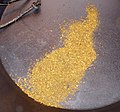File:Gold dust (placer gold) 2 (16849889230).jpg

原始文件 (3,052 × 2,844像素,文件大小:3.78 MB,MIME类型:image/jpeg)
摘要
| 描述Gold dust (placer gold) 2 (16849889230).jpg |
Gold dust (placer gold) (DRA 101.1, Draper Museum of Natural History, Cody, Wyoming, USA) A mineral is a naturally-occurring, solid, inorganic, crystalline substrance having a fairly definite chemical composition and having fairly definite physical properties. At its simplest, a mineral is a naturally-occurring solid chemical. Currently, there are over 4900 named and described minerals - about 200 of them are common and about 20 of them are very common. Mineral classification is based on anion chemistry. Major categories of minerals are: elements, sulfides, oxides, halides, carbonates, sulfates, phosphates, and silicates. Elements are fundamental substances of matter - matter that is composed of the same types of atoms. At present, 118 elements are known (four of them are still unnamed). Of these, 98 occur naturally on Earth (hydrogen to californium). Most of these occur in rocks & minerals, although some occur in very small, trace amounts. Only some elements occur in their native elemental state as minerals. To find a native element in nature, it must be relatively non-reactive and there must be some concentration process. Metallic, semimetallic (metalloid), and nonmetallic elements are known in their native state as minerals. Gold (Au) is the most prestigious metal known, but it's not the most valuable. Gold is the only metal that has a deep, rich, metallic yellow color. Almost all other metals are silvery-colored. Gold is very rare in crustal rocks - it averages about 5 ppb (parts per billion). Where gold has been concentrated, it occurs as wires, dendritic crystals, twisted sheets, octahedral crystals, and variably-shaped nuggets. It most commonly occurs in hydrothermal quartz veins, disseminated in some contact- & hydrothermal-metamorphic rocks, and in placer deposits. Placers are concentrations of heavy minerals in stream gravels or in cracks on bedrock-floored streams. Gold has a high specific gravity (about 19), so it easily accumulates in placer deposits. Its high density allows prospectors to readily collect placer gold by panning. In addition to its high density, gold has a high melting point (over 1000º C). Gold is also relatively soft - about 2.5 to 3 on the Mohs Hardness Scale. The use of pure gold or high-purity gold in jewelry is not desirable as it easily gets scratched. The addition of other metals to gold to increase the hardness also alters the unique color of gold. Gold jewelry made & sold in America doesn’t have the gorgeous rich color of high-purity gold. The gold dust shown above is placer gold, derived from river or stream sediments. "Gold dust" essentially refers to very small gold nuggets. The provenance of this gold dust is not disclosed on public signage at the museum. However, I suspect it might be from California. The donor of this gold dust is the eccentric millionaire Forrest Fenn, who famously buried a treasure chest in the New Mexico Rocky Mountains. The chest contains a jar of gold dust that he says was from California's mid-1800s gold rush. The gold dust shown above may be a subsample of that material. |
| 日期 | |
| 来源 | Gold dust (placer gold) 2 |
| 作者 | James St. John |
许可协议
| 这幅图片原始出处为Flickr的https://www.flickr.com/photos/47445767@N05/16849889230 ,作者为jsj1771 。经机器人FlickreviewR在2015年4月6日审查后确定为采用cc-by-2.0的协议授权使用。 |
2015年4月6日
说明
此文件中描述的项目
描绘内容
创作作者 简体中文(已转写)
某些值没有维基数据项目
知识共享署名2.0通用 简体中文(已转写)
摄影器材 简体中文(已转写)
15 8 2010
曝光时间 简体中文(已转写)
0.01666666666666666666 秒
焦距比数 简体中文(已转写)
4.9
焦距 简体中文(已转写)
18.6 毫米
ISO速度 简体中文(已转写)
250
文件历史
点击某个日期/时间查看对应时刻的文件。
| 日期/时间 | 缩略图 | 大小 | 用户 | 备注 | |
|---|---|---|---|---|---|
| 当前 | 2015年4月6日 (一) 20:36 |  | 3,052 × 2,844(3.78 MB) | Jacopo Werther | Transferred from Flickr via Flickr2Commons |
文件用途
以下页面使用本文件:
全域文件用途
元数据
此文件中包含有扩展的信息。这些信息可能是由数码相机或扫描仪在创建或数字化过程中所添加。
如果此文件的源文件已经被修改,一些信息在修改后的文件中将不能完全反映出来。
| 相机制造商 | Canon |
|---|---|
| 相机型号 | Canon PowerShot D10 |
| 曝光时间 | 1/60秒(0.016666666666667) |
| 光圈值 | f/4.9 |
| 感光度(ISO) | 250 |
| 数据生成日期时间 | 2010年8月15日 (日) 13:56 |
| 镜头焦距 | 18.6毫米 |
| 图像标题 | |
| 宽度 | 4,000 px |
| 高度 | 3,000 px |
| 每色彩组分位数 |
|
| 像素构成 | RGB |
| 方向 | 正常 |
| 色彩组分数 | 3 |
| 水平分辨率 | 180 dpi |
| 垂直分辨率 | 180 dpi |
| 使用软件 | Adobe Photoshop Elements 13.0 (Macintosh) |
| 文件修改日期时间 | 2015年4月5日 (日) 00:20 |
| 亮度(Y)和色度(C)位置 | 重叠 |
| Exif版本 | 2.21 |
| 数字化日期时间 | 2010年8月15日 (日) 13:56 |
| 每个色彩组分意义 |
|
| 图像压缩模式 | 3 |
| APEX快门速度 | 5.90625 |
| APEX光圈 | 4.59375 |
| APEX曝光补偿 | 0 |
| 最大光圈 | 4.59375 APEX(f/4.91) |
| 测光模式 | 多区 |
| 闪光灯 | 闪光灯点亮、自动模式、防红眼模式 |
| 支持的Flashpix版本 | 1 |
| 色彩空间 | sRGB |
| 焦平面X分辨率 | 16,460.905349794 |
| 焦平面Y分辨率 | 16,483.516483516 |
| 焦平面分辨率单位 | 英寸 |
| 感光方法 | 单芯片彩色区域传感器 |
| 文件来源 | 数码相机 |
| 自订图像处理 | 普通处理 |
| 曝光模式 | 自动曝光 |
| 白平衡 | 自动白平衡 |
| 数字变焦比率 | 1 |
| 场景拍摄类型 | 标准 |
| 使用的镜头 | 6.2-18.6 mm |
| 元数据最后修改日期 | 2015年4月4日 (六) 20:20 |
| 原始文件唯一ID | 76E78045657F31899B664D27CC34D070 |
| IIM版本 | 17,259 |

